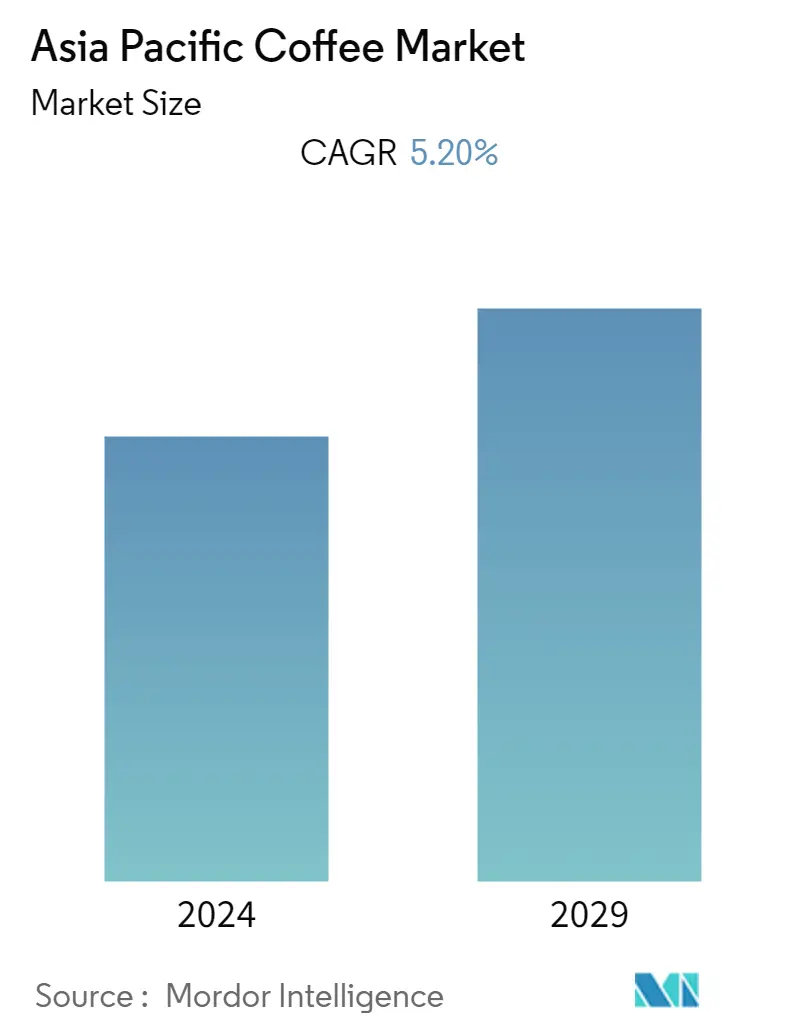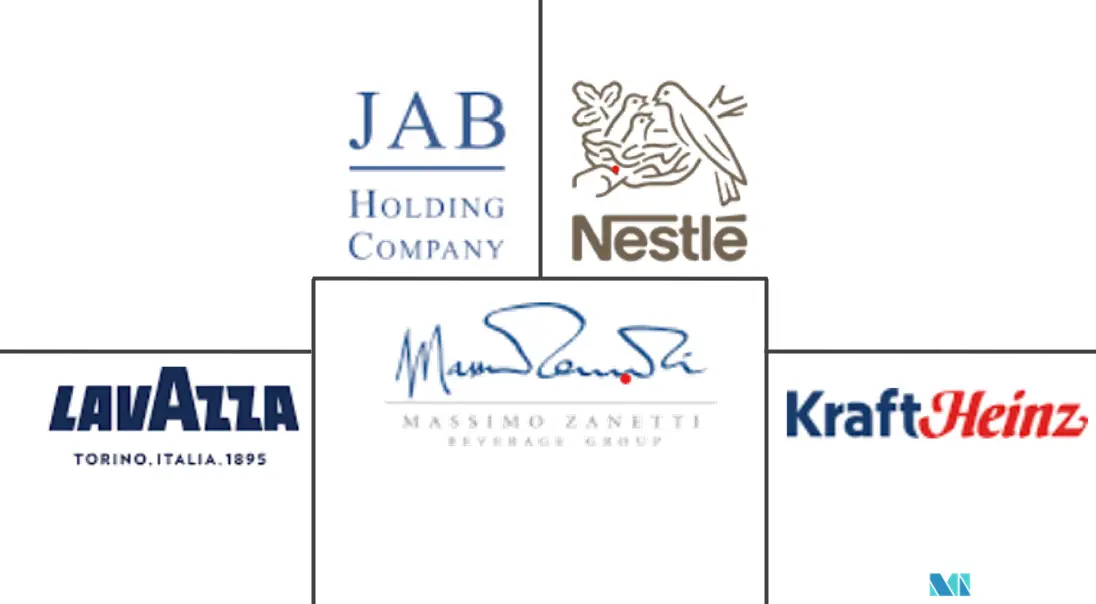Market Size of Asia Pacific Coffee Industry

| Study Period | 2019 - 2029 |
| Base Year For Estimation | 2023 |
| Forecast Data Period | 2024 - 2029 |
| Historical Data Period | 2019 - 2022 |
| CAGR | 5.20 % |
| Market Concentration | High |
Major Players
*Disclaimer: Major Players sorted in no particular order |
APAC Coffee Market Analysis
Asia Pacific coffee market is projected to register a CAGR of 5.2% during the forecast period, 2022-2027.
With the growing culture of consuming coffee as a refreshing drink among the younger population, especially in India, China, Japan, and the Philippines, the market for coffee is rising. In addition, the increasing disposable income coupled with urbanization is the major factor contributing to the growth of the Asia Pacific coffee market. For instance, in 2020-2021, as per ICO (International Coffee Organization), Japan consumed nearly 7303 bags (in thousands of 60-kg bags) of coffee, boosting the coffee market.
Various health benefits of consuming coffee, such as reducing the risk of diabetes, fat burning, and high energy intake from caffeine spikes are also driving the market growth. Consumers are shifting towards more organic or plant-based coffee to maintain a healthy lifestyle. Hence, key players are engaged in product innovations, to maintain a stronger foothold in the region. For instance, in 2021 Nestle Japan launched a range of Nescafé lattes which include coffee capsules, crafted with plant-based ingredients, to meet the rapidly growing interest in plant-based food in Japan.
However, covid restrictions such as travel restrictions, limitations to global trade networks, and operational limitations caused supply chain disruptions resulting in huge revenue losses in the Asia Pacific coffee business.
APAC Coffee Industry Segmentation
Coffee is the most popular and consumed brewed drink prepared from roasted coffee beans, which are the seeds of a certain Coffea species. Further, the coffee market is segmented by product type, distribution channel, and geography. Based on product type, the coffee market is segmented into whole-bean, ground coffee, instant coffee, and coffee pods and capsules. Based on the distribution channel, the market is segmented into supermarkets/hypermarkets, convenience stores, online retail stores, and other distribution channels. By geography, the market is segmented into India, China, Japan, Australia, and the Rest of Asia Pacific. For each segment, the market sizing and forecasts have been done based on value (in USD million).
| By Type | |
| Whole-bean | |
| Ground Coffee | |
| Instant Coffe | |
| Coffee Pods, and Capsules |
| By Distribution | |
| Supermarkets/Hypermarkets | |
| Convenience stores | |
| Online Retail Stores | |
| Other distribution channels |
| By Geography | |
| India | |
| China | |
| Japan | |
| Australia | |
| Rest of Asia Pacific |
Asia Pacific Coffee Market Size Summary
The Asia Pacific coffee market is experiencing a robust growth trajectory, driven by a burgeoning coffee culture among the younger demographic in countries like India, China, Japan, and the Philippines. This growth is further fueled by increasing disposable incomes and urbanization, which are expanding the consumer base for coffee products. The market is also witnessing a shift towards organic and plant-based coffee options, as consumers become more health-conscious and seek products that align with their lifestyle choices. Key industry players are responding to these trends by innovating and expanding their product offerings, such as Nestle Japan's introduction of plant-based coffee capsules. Despite challenges posed by supply chain disruptions during the COVID-19 pandemic, the market continues to thrive, with a growing emphasis on ethical and organic coffee products, particularly in India and China.
The demand for coffee in the Asia Pacific region is further bolstered by the urbanized and affluent populations in countries like China, India, and Japan, who are increasingly seeking new flavors and experiences. The Chinese coffee market, in particular, is witnessing significant growth, with domestic brands gaining popularity as consumers shift away from Western coffee options. This has led to an expansion of coffee chains and brands in the region, with companies like Trung Nguyen and BeStar Coffee opening new locations to capture market share. The market is characterized by a fragmented landscape with numerous players employing strategies such as mergers, acquisitions, and partnerships to enhance their presence and product portfolios. Prominent companies like Nestle, JAB Holding Company, and LUIGI LAVAZZA SPA are actively investing in the region to capitalize on the growing demand, further driving the market's expansion.
Asia Pacific Coffee Market Size - Table of Contents
-
1. MARKET DYNAMICS
-
1.1 Market Drivers
-
1.2 Market Restraints
-
1.3 Porter's Five Force Analysis
-
1.3.1 Threat of New Entrants
-
1.3.2 Bargaining Power of Buyers/Consumers
-
1.3.3 Bargaining Power of Suppliers
-
1.3.4 Threat of Substitute Products
-
1.3.5 Intensity of Competitive Rivalry
-
-
-
2. MARKET SEGMENTATION
-
2.1 By Type
-
2.1.1 Whole-bean
-
2.1.2 Ground Coffee
-
2.1.3 Instant Coffe
-
2.1.4 Coffee Pods, and Capsules
-
-
2.2 By Distribution
-
2.2.1 Supermarkets/Hypermarkets
-
2.2.2 Convenience stores
-
2.2.3 Online Retail Stores
-
2.2.4 Other distribution channels
-
-
2.3 By Geography
-
2.3.1 India
-
2.3.2 China
-
2.3.3 Japan
-
2.3.4 Australia
-
2.3.5 Rest of Asia Pacific
-
-
Asia Pacific Coffee Market Size FAQs
What is the current Asia Pacific Coffee Market size?
The Asia Pacific Coffee Market is projected to register a CAGR of 5.20% during the forecast period (2024-2029)
Who are the key players in Asia Pacific Coffee Market?
JAB Holding Company, The Kraft Heinz Company, Massimo Zanetti Beverage Group, LUIGI LAVAZZA SPA and Nestle SA are the major companies operating in the Asia Pacific Coffee Market.

